Papers by Georgios Kraniotis

Classical and Quantum Gravity
The curvature scalar invariants of the Riemann tensor are important in General Relativity because... more The curvature scalar invariants of the Riemann tensor are important in General Relativity because they allow a manifestly coordinate invariant characterisation of certain geometrical properties of spacetimes such as, among others, curvature singularities, gravitomagnetism. We calculate explicit analytic expressions for the set of Zakhary-McIntosh curvature invariants for accelerating Kerr-Newman black holes in (anti-)de Sitter spacetime as well as for the Kerr-Newman-(anti-)de Sitter black hole. These black hole metrics belong to the most general type D solution of the Einstein-Maxwell equations with a cosmological constant. Explicit analytic expressions for the Euler-Poincare density invariant, which is relevant for the computation of the Euler-Poincare characteristic χ(M), and the Kretschmann scalar are also provided for both cases. We perform a detailed plotting of the curvature invariants that reveal a rich structure of the spacetime geometry surrounding the singularity of a rot...

Exact solutions of the Klein-Gordon-Fock (KGF) general relativistic equation that describe the dy... more Exact solutions of the Klein-Gordon-Fock (KGF) general relativistic equation that describe the dynamics of a massive, electrically charged scalar particle in the curved spacetime geometry of a charged, rotating Kerr-Newman-(anti) de Sitter black hole are investigated. In the general case of a rotating, charged, cosmological black hole the solution of the KGF equation with the method of separation of variables results in Fuchsian differential equations for the radial and angular parts which contain more than three finite singularities and thereby generalise the Heun differential equations (HE). For particular values of the physical parameters (i.e mass of the scalar particle) these Fuchsian equations reduce to Heun equations and the solutions are expressed in terms of Heun functions. For other values of the parameters some of the extra singular points are false singular points. We derive the conditions on the coefficients of the generalised Fuchsian equation such that a singular poin...
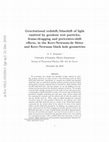
We investigate the redshift and blueshift of light emitted by timelike geodesic particles in orbi... more We investigate the redshift and blueshift of light emitted by timelike geodesic particles in orbits around a Kerr-Newman-(anti) de Sitter (KN(a)dS) black hole. Specifically we compute the redshift and blueshift of photons that are emitted by geodesic massive particles and travel along null geodesics towards a distant observer-located at a finite distance from the KN(a)dS black hole. For this purpose we use the Killing-vector formalism and the associated first integrals-constants of motion. We consider in detail stable timelike equatorial circular orbits of stars and express their corresponding redshift/blueshift in terms of the metric physical black hole parameters (angular momentum per unit mass, mass, electric charge and the cosmological constant) and the orbital radii of both the emitter star and the distant observer. These radii are linked through the constants of motion along the null geodesics followed by the photons since their emission until their detection and as a result w...
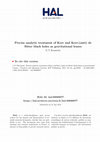
The null geodesic equations that describe motion of photons in Kerr spacetime are solved exactly ... more The null geodesic equations that describe motion of photons in Kerr spacetime are solved exactly in the presence of the cosmological constant Λ. The exact solution for the deflection angle for generic light orbits (i.e. non-polar, non-equatorial) is calculated in terms of the generalized hypergeometric functions of Appell and Lauricella. We then consider the more involved issue in which the black hole acts as a `gravitational lens'. The constructed Kerr black hole gravitational lens geometry consists of an observer and a source located far away and placed at arbitrary inclination with respect to the black hole's equatorial plane. The resulting lens equations are solved elegantly in terms of Appell-Lauricella hypergeometric functions and the Weierstrass elliptic function. We then, systematically, apply our closed form solutions for calculating the image and source positions of generic photon orbits that solve the lens equations and reach an observer located at various values ...
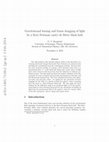
The null geodesics that describe photon orbits in the spacetime of a rotating electrically charge... more The null geodesics that describe photon orbits in the spacetime of a rotating electrically charged black hole (Kerr-Newman) are solved exactly including the contribution from the cosmological constant. We derive elegant closed form solutions for relativistic observables such as the deflection angle and frame dragging effect that a light ray experiences in the gravitational fields (i) of a Kerr-Newman black hole and (ii) of a Kerr-Newman-de Sitter black hole. We then solve the more involved problem of treating a Kerr-Newman black hole as a gravitational lens, i.e. a KN black hole along with a static source of light and a static observer both located far away but otherwise at arbitrary positions in space. For this model, we derive the analytic solutions of the lens equations in terms of Appell and Lauricella hypergeometric functions and the Weierstra\ss modular form. The exact solutions derived for null, spherical polar and non-polar orbits, are applied for the calculation of frame dr...
We solve in closed analytic form space-like geodesic equations in the Kerr gravitational field. S... more We solve in closed analytic form space-like geodesic equations in the Kerr gravitational field. Such geodesic equations describe the motion of neutral tachyons (faster than light particles) in the Kerr spacetime. More specifically we derive the closed form solution for the deflection angle of a neutral tachyon on an equatorial orbit in Kerr spacetime. The solution is expressed elegantly in terms of Lauricella's hypergeometric function FD.We applied our results to three cases: first, for the calculation of the deflection angle of a neutral tachyon on an equatorial trajectory in the gravitational field of a Kerr black hole. Subsequently, we applied our exact solutions to compute the deflection angle of equatorial spacelike geodesics in the gravitational fields of Sun and Earth assuming the Kerr spacetime geometry.
arXiv: General Relativity and Quantum Cosmology, 2011
We solve in closed analytic form space-like geodesic equations in the Kerr gravitational field. S... more We solve in closed analytic form space-like geodesic equations in the Kerr gravitational field. Such geodesic equations describe the motion of neutral tachyons (faster than light particles) in the Kerr spacetime. More specifically we derive the closed form solution for the deflection angle of a neutral tachyon on an equatorial orbit in Kerr spacetime. The solution is expressed elegantly in terms of Lauricella's hypergeometric function F_{D}.We applied our results to three cases: first, for the calculation of the deflection angle of a neutral tachyon on an equatorial trajectory in the gravitational field of a Kerr black hole. Subsequently, we applied our exact solutions to compute the deflection angle of equatorial spacelike geodesics in the gravitational fields of Sun and Earth assuming the Kerr spacetime geometry.

Exact solutions of the Dirac general relativistic equation that describe the dynamics of a massiv... more Exact solutions of the Dirac general relativistic equation that describe the dynamics of a massive, electrically charged particle with half-integer spin in the curved spacetime geometry of an electrically charged, rotating Kerr-Newman-(anti) de Sitter black hole are investigated. We first, derive the Dirac equation in the Kerr-Newman-de Sitter (KNdS) black hole background using a generalised Kinnersley null tetrad in the NewmanPenrose formalism. Subsequently in this frame and in the KNdS black hole spacetime, we prove the separation of the Dirac equation into ordinary differential equations for the radial and angular parts. Under specific transformations of the independent and dependent variables we prove that the transformed radial equation for a massive charged spin 1 2 fermion in the background KNdS black hole constitutes a highly non-trivial generalisation of Heun’s equation since it possess five regular finite singular points. Using a Regge-Wheeler-like independent variable we ...
arXiv: Mathematical Physics, 2013
We derive the closed form solutions for the surface area, the capacitance and the demagnetizing f... more We derive the closed form solutions for the surface area, the capacitance and the demagnetizing factors of the ellipsoid immersed in the Euclidean space R^3. The exact solutions for the above geometrical and physical properties of the ellipsoid are expressed elegantly in terms of the generalized hypergeometric functions of Appell of two variables. Various limiting cases of the theorems of the exact solution for the surface area, the demagnetizing factors and the capacitance of the ellipsoid are derived, which agree with known solutions for the prolate and oblate spheroids and the sphere. Possible applications of the results achieved, in various fields of science, such as in physics, biology and space science are briefly discussed.
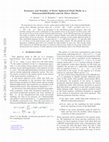
Physical Review D
We demonstrate the existence of static stable spherical fluid shells in the Schwarzschild-Rindler... more We demonstrate the existence of static stable spherical fluid shells in the Schwarzschild-Rindleranti-de Sitter (SRAdS) spacetime where ds 2 = f (r)dt 2 − dr 2 f (r) − r 2 (dθ 2 + sin 2 θdφ 2) with f (r) = 1 − 2Gm r + 2br − Λ 3 r 2. This is an alternative to the well known gravastar geometry where the stability emerges due to the combination of the repulsive forces of the interior de Sitter space with the attractive forces of the exterior Schwarzschild spacetime. In the SRAdS spacetime the repulsion that leads to stability of the shell comes from a negative Rindler term while the Schwarzschild and anti-de Sitter terms are attractive. We demonstrate the existence of such stable spherical shells for three shell fluid equations of state: vacuum shell (p = −σ), stiff matter shell (p = σ) and dust shell (p = 0) where p is the shell pressure and σ is the shell surface density. We also identify the metric parameter conditions that need to be satisfied for shell stability in each case. The vacuum stable shell solution in the SRAdS spacetime is consistent with previous studies by two of the authors that demonstrated the existence sf stable spherical scalar field domain walls in the SRAdS spacetime.
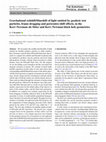
The European Physical Journal C
We investigate the redshift and blueshift of light emitted by timelike geodesic particles in orbi... more We investigate the redshift and blueshift of light emitted by timelike geodesic particles in orbits around a Kerr–Newman–(anti) de Sitter (KN(a)dS) black hole. Specifically we compute the redshift and blueshift of photons that are emitted by geodesic massive particles and travel along null geodesics towards a distant observer-located at a finite distance from the KN(a)dS black hole. For this purpose we use the killing-vector formalism and the associated first integrals-constants of motion. We consider in detail stable timelike equatorial circular orbits of stars and express their corresponding redshift/blueshift in terms of the metric physical black hole parameters (angular momentum per unit mass, mass, electric charge and the cosmological constant) and the orbital radii of both the emitter star and the distant observer. These radii are linked through the constants of motion along the null geodesics followed by the photons since their emission until their detection and as a result w...
Classical and Quantum Gravity
Exact solutions of the Klein-Gordon-Fock (KGF) general relativistic equation that describe the dy... more Exact solutions of the Klein-Gordon-Fock (KGF) general relativistic equation that describe the dynamics of a massive, electrically charged scalar particle in the curved spacetime geometry of an electrically charged, rotating Kerr-Newman-(anti) de Sitter black hole are investigated. In the general case of a rotating, charged, cosmological black hole the solution

General Relativity and Gravitation, 2014
The null geodesics that describe photon orbits in the spacetime of a rotating electrically charge... more The null geodesics that describe photon orbits in the spacetime of a rotating electrically charged black hole (Kerr-Newman) are solved exactly including the contribution from the cosmological constant. We derive elegant closed form solutions for relativistic observables such as the deflection angle and frame dragging effect that a light ray experiences in the gravitational fields (i) of a Kerr-Newman black hole and (ii) of a Kerr-Newman-de Sitter black hole. We then solve the more involved problem of treating a Kerr-Newman black hole as a gravitational lens, i.e. a KN black hole along with a static source of light and a static observer both located far away but otherwise at arbitrary positions in space. For this model, we derive the analytic solutions of the lens equations in terms of Appell and Lauricella hypergeometric functions and the Weierstraß modular form. The exact solutions derived for null, spherical polar and non-polar orbits, are applied for the calculation of frame dragging for the orbit of a photon around the galactic centre, assuming that the latter is a Kerr-Newman black hole. We also apply the exact solution for the deflection angle of an equatorial light ray in the gravitational field of a Kerr-Newman black hole for the calculation of bending of light from the gravitational field of the galactic centre for various values of the Kerr parameter, electric charge and impact factor. In addition, we derive expressions for the Maxwell tensor components for a Zero-Angular-Momentum-Observer (ZAMO) in the Kerr-Newman-de Sitter spacetime.

Classical and Quantum Gravity, 2011
The null geodesic equations that describe motion of photons in Kerr spacetime are solved exactly ... more The null geodesic equations that describe motion of photons in Kerr spacetime are solved exactly in the presence of the cosmological constant Λ. The exact solution for the deflection angle for generic light orbits (i.e. non-polar, non-equatorial) is calculated in terms of the generalized hypergeometric functions of Appell and Lauricella. We then consider the more involved issue in which the black hole acts as a 'gravitational lens'. The constructed Kerr black hole gravitational lens geometry consists of an observer and a source located far away and placed at arbitrary inclination with respect to black hole's equatorial plane. The resulting lens equations are solved elegantly in terms of Appell-Lauricella hypergeometric functions and the Weierstraß elliptic function. We then, systematically, apply our closed form solutions for calculating the image and source positions of generic photon orbits that solve the lens equations and reach an observer located at various values of the polar angle for various values of the Kerr parameter and the first integrals of motion. In this framework, the magnification factors for generic orbits are calculated in closed analytic form for the first time. The exercise is repeated with the appropriate modifications for the case of non-zero cosmological constant.
… and Detection of Dark Matter and …, 2001
Page 90. Measurement of the Cosmological Constant from Galactic Velocity Rotation Data Georgios V... more Page 90. Measurement of the Cosmological Constant from Galactic Velocity Rotation Data Georgios V. Kraniotis1 and Steven B. Whitehouse1 Royal Holloway University of London, Centre for Particle Physics, Egham Surrey, TW20-OEX, UK Abstract. ...
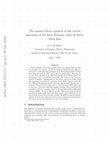
Exact solutions of the Dirac general relativistic equation (DE) that describe the dynamics of a m... more Exact solutions of the Dirac general relativistic equation (DE) that describe the dynamics of a massive, electrically charged particle with half-integer spin in the curved spacetime geometry of an electrically charged, rotating Kerr-Newman-(anti) de Sitter black hole (BH) are investigated. We first, derive the DE in the Kerr-Newman-de Sitter (KNdS) BH background using a generalised Kinnersley null tetrad in the Newman-Penrose formalism. In this frame, we prove the separation of the DE into ordinary differential equations for the radial and angular parts. Under specific transformations of the independent and dependent variables we prove that the transformed radial equation for a massive charged spin 1/2 fermion in the background KNdS BH constitutes a highly non-trivial generalisation of Heun's equation. Using a Regge-Wheeler-like independent variable we transform the radial equation in the KNdS background into a Schrödinger-like differential equation and investigate its asymptoti...

Journal of Physics Communications
Exact solutions of the Dirac general relativistic equation that describe the dynamics of a massiv... more Exact solutions of the Dirac general relativistic equation that describe the dynamics of a massive, electrically charged particle with half-integer spin in the curved spacetime geometry of an electrically charged, rotating Kerr-Newman-(anti) de Sitter black hole are investigated. We first, derive the Dirac equation in the Kerr-Newman-de Sitter (KNdS) black hole background using a generalised Kinnersley null tetrad in the Newman-Penrose formalism. Subsequently in this frame and in the KNdS black hole spacetime, we prove the separation of the Dirac equation into ordinary differential equations for the radial and angular parts. Under specific transformations of the independent and dependent variables we prove that the transformed radial equation for a massive charged spin 1 2 fermion in the background KNdS black hole constitutes a highly non-trivial generalisation of Heun's equation since it possess five regular finite singular points. Using a Regge-Wheeler-like independent variable we transform the radial equation in the KNdS background into a Schrödinger like differential equation and investigate its asymptotic behaviour near the event and cosmological horizons. For the case of a massive fermion in the background of a Kerr-Newman (KN) black hole we first prove that the radial and angular equations that result from the separation of Dirac's equation reduce to the generalised Heun differential equation (GHE). The local solutions of such GHE are derived and can be described by holomorphic functions whose power series coefficients are determined by a four-term recurrence relation. In addition using asymptotic analysis we derive the solutions for the massive fermion far away from the KN black hole and the solutions near the event horizon. The determination of the separation
Journal of High Energy Physics, 2003
Gauge coupling constant ratios close to those measured are easily obtained for reasonable values ... more Gauge coupling constant ratios close to those measured are easily obtained for reasonable values of the parameters, consistently with having the string scale close to the electroweak scale, as required to avoid the hierarchy problem. Unwanted (colour-triplet, charged-singlet, and neutral-singlet) scalar tachyons can be removed by a suitable choice of the parameters.









Uploads
Papers by Georgios Kraniotis